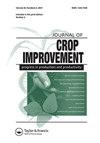Application of Ceres-Millet model of DSSAT for simulating millet varieties under different sowing windows in Niger
IF 1.5
Q3 AGRONOMY
引用次数: 0
Abstract
ABSTRACT Choosing an appropriate variety and planting date could help farmers increase the recurrent low pearl millet (Pennisetum glaucum (L.) R. Br.) yields recorded in Niger. Field experiments were conducted at the National Agricultural Research Institute of Niger (N’Dounga) during the 2016 and 2017 rainy seasons to evaluate the performance of the CERES-Millet model in simulating the growth and yield of pearl millet varieties. Treatments consisted of two sowing windows (late June and mid-July) and four varieties (HKP, ZATIB, CIVT, and H80-10 GR) arranged in a split-plot design with three replications. Sowing dates were allocated to the main plots, whereas varieties were assigned to the subplots. The data collected on days to 50% flowering, days to physiological maturity, grain yield, and above-ground biomass during 2016 and 2017 were used to calibrate and evaluate the CERES-Millet model for simulating sowing windows. The model was used to simulate the long-term effects of different sowing windows using long-term historical weather data from 1983 to 2017 in Kollo. The results for model calibration showed that simulated growth and yield of millet were in good agreement with their corresponding observed values. The d-index was 0.99 for days to anthesis, 0.97 for days to physiological maturity, 0.93 for grain yield, and 0.79 for above-ground biomass. The results for both calibration and evaluation showed that normalized root mean square errors were less than 10%. The values of the d-index were also within the acceptable range for all the parameters. Therefore, the CERES-Millet model was robust enough to successfully simulate millet growth and yield in Niger. Seasonal analysis revealed that sowing should be done from early June to mid-June for ZATIB and H80-10 GR varieties. However, it should be done from early June to late June for CIVT and from mid-June to early July for HKP.DSSAT谷神星-小米模型在尼日尔不同播种窗口下模拟小米品种中的应用
摘要选择合适的品种和种植日期可以帮助农民提高尼日尔低珍珠谷的产量。尼日尔国家农业研究所在2016年和2017年雨季进行了田间试验,以评估CERES小米模型在模拟珍珠小米品种生长和产量方面的性能。处理包括两个播种窗口(6月下旬和7月中旬)和四个品种(HKP、ZATIB、CIVT和H80-10 GR),以三次重复的分块设计进行排列。播种日期被分配到主要地块,而品种被分配到次要地块。2016年和2017年期间收集的50%开花天数、生理成熟天数、粮食产量和地上生物量数据用于校准和评估CERES Millet模型,用于模拟播种窗口。该模型用于利用1983年至2017年Kollo的长期历史天气数据模拟不同播种窗口的长期影响。模型标定结果表明,模拟的谷子生长和产量与相应的观测值吻合较好。开花天数的d指数为0.99,生理成熟天数为0.97,粮食产量为0.93,地上生物量为0.79。校准和评估的结果表明,归一化均方根误差小于10%。d指数的值也在所有参数的可接受范围内。因此,CERES Millet模型足够稳健,可以成功模拟尼日尔的小米生长和产量。季节分析表明,ZATIB和H80-10GR品种应在6月初至6月中旬播种。然而,CIVT应在6月初至6月底进行,HKP应在6月中至7月初进行。
本文章由计算机程序翻译,如有差异,请以英文原文为准。
求助全文
约1分钟内获得全文
求助全文
来源期刊

Journal of Crop Improvement
Multiple-
CiteScore
3.30
自引率
7.70%
发文量
42
期刊介绍:
Journal of Crop Science and Biotechnology (JCSB) is a peer-reviewed international journal published four times a year. JCSB publishes novel and advanced original research articles on topics related to the production science of field crops and resource plants, including cropping systems, sustainable agriculture, environmental change, post-harvest management, biodiversity, crop improvement, and recent advances in physiology and molecular biology. Also covered are related subjects in a wide range of sciences such as the ecological and physiological aspects of crop production and genetic, breeding, and biotechnological approaches for crop improvement.
 求助内容:
求助内容: 应助结果提醒方式:
应助结果提醒方式:


